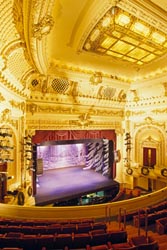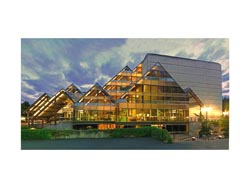All The World's A Stage

- Schouwburg Almere features a entire speaker system that can be raised and lowered on hoists to suit the physical design of each production, without adversely affecting the audio coverage of the venue.Not so long ago, our performance spaces were designed with one particular function in mind. Theaters were for the spoken word. Symphonic halls catered for classical repertoire and other forms of unamplified music. Movie theaters were for...well, showing movies. And any venue operator who tried to convince a rock band to play an opera house (or, even less likely, an opera house to host a rock band) was considered eccentric, if not downright foolhardy.
- Times change. Concert halls that could once rely on public subsidy to fund programs of minority interest may now need to diversify in order to remain viable. Historic theaters may host touring musicals to subsidize their more erudite output. And all kinds of performance venues now stage events that are not strictly 'live'-from corporate events with pre-recorded show content, to movies and more.
- Before we venture too far down the road toward some multi-purpose ideal, however, it's best to remember what it is that has driven theaters into existence in the first place, and what (in many cases) continues to do so. As Sam Wise of Arup Venue Consulting, whose company has worked on dozens of performance venues all over the world, put it, "More and more projects are multi-purpose, but they still have strong biases in terms of why the client has started to build them. There's normally a key usage, which is some kind of spoken-word theatre, a musical requirement, or an educational requirement that drives the venue into existence.
- "After that, a financial spreadsheet has to be generated, and it's at that stage that the appeal of the venue starts to get broadened, as a means of paying for everything the client wants to achieve."
Formerly only available as vast desks which remained almost the sole preserve of the rental community, digital mixers like this Soundcraft Vi4 at the Konzerthaus in Dortmund, Germany are today available with a smaller footprint, making them not just more affordable to theaters to buy, but also easier to accommodate physically and less likely to occupy precious revenue-generating seat space.
Today, most new-build theater installations-and many refurbishment projects-have the need for a consultant to act as the link between architect, end user, and systems contractor. Few markets are as consultant-driven as this. One of the reasons is the venue acoustics, which assume far greater importance in a theater than in, say, a corporate boardroom or retail project.
"One of our driving forces is the room," said Wise. "The systems are secondary. Making a room that's ideal for its purposes acoustically means you can bring in a wide variety of sound systems, and they'll all sound good. Our goal as venue consultants is to make the building amenable to all kinds of uses, and to all kinds of technology over time.
"We're concentrating on the building being strong enough at the right points so that you can hang what you need to hang, where you need to hang it. We're looking at power supplies so that you don't get unwanted noise, hum, and so forth. And we're looking at the cabled network that will enable the right kinds of system technology to be used, now and in the future. For audio purposes, that means perhaps 50ohm coax, 75ohm coax, Cat cable and fiber, plus a multicore cable that will run AES/EBU or analog. Adding a few cables during construction is relatively cheap-much cheaper than rewiring later."

A reconfigurable M'elodie compact setup from Meyer Sound gives Pantages Theatre the flexibility it needs for its wide range of performances while remaining relatively discreet, both visually and sonically.
Schouwburg Almere is a receiving house that tends to host touring acts, rather than staging its own productions. Some shows play for just one night, so changes in system configuration need to be as speedy as they are smooth. To cater to this need, Wagenaar collaborated with audio consultancy Team Projects to create custom beam-steering software for the venue's Peavey Nion MediaMatrix signal processors, which provides full EQ and delay control over each loudspeaker in the main theater's Martin Audio W8LM front-of-house system.
"In addition," said Wagenaar, "the entire speaker system can be raised and lowered on hoists to suit the physical design of each production, without adversely affecting the audio coverage of the venue."
Aesthetically Speaking
While conspicuous displays of new technology may find favor in modernist buildings like the Schouwburg Almere, not every theater presents contractors with a similarly tolerant aesthetic. Additionally, the promoters of some types of entertainment place a certain value on loudspeaker systems, for example, being out of sight.
This is why the Pantages Theatre in Tacoma, WA, has also opted for a movable line-array system-in this case a reconfigurable M'elodie compact setup from Meyer Sound. "We have 10 resident arts organizations performing here, and each of them have their own set of priorities," said Scott Painter, the venue's production stage manager. "Some, such as the ballet and the opera, don't want to see speakers hanging at all."
Even when the Pantages' arrays are lowered, they remain relatively discreet, not only visually but also sonically. The theater, which is nearly a century old, is wide and shallow, measuring just 80 feet from the proscenium to the back wall. Many speaker systems would have been too large, but over the past couple of years, manufacturers have increasingly come to realize that developing compact versions of line arrays enables them to broaden their range of potential venue customers considerably.
The same is true of other pieces of technology, such as digital mixing consoles. Formerly only available as vast desks which remained almost the sole preserve of the rental community, digital mixers are today available with a smaller footprint, making them not just more affordable to theaters to buy, but also easier to accommodate physically and less likely to occupy precious revenue-generating seat space.
A daily selection of the top stories for AV integrators, resellers and consultants. Sign up below.
When the new Konzerthaus opened in Dortmund, Germany, in 2002, the installed sound system was designed for voice transmission only, since the primary intention was to offer classical concerts in an acoustically optimized hall. But the number of shows requiring dedicated sound-reinforcement grew steadily, and earlier this year the venue decided to invest in a new audio infrastructure of its own. The theater's head of stage management, Ralf Leyk, originally favored an analog Soundcraft MH3 mixing console for FOH, but then Dortmund-based B&B Veranstaltungstechnik supplied a Soundcaft Vi4-the small-footprint version of the company's Vi6 digital mixer platform-for a show in the building's lobby.
"I suggested to Ralf Leyk that he take a closer look," said B&B system designer Sebastian Müller-Eckhard, "and a few days later, the Vi4 was specified for the main installation. It is smaller and lighter than an analog desk, so fewer hands were needed to set it up. Plus, the Cat-5 cable is far easier to run than analog multicore, and with all the onboard possibilities, it's easy to control the whole system."
Of course, there will always be theater venues that cannot justify having a full sound reinforcement system of their own. For them, it will be sufficient to have paging, intercom systems, and the like, and simply provide LCR hoists so that touring acts can bring in their own rigs. But as advances in compact, versatile, unobtrusive, and affordable technology continue to be made, those venues are going to become part of an ever smaller minority.

The Hult Center for the Performing Arts in Eugene, OR.
Higher Levels Of Assistance
Providing support for assistive listening is rapidly becoming the norm for theaters across North America, and the Hult Center for the Performing Arts in Eugene, OR, is just one example. A multi-venue project that caters to a wide variety of arts interests for the local community, the Hult Center recently updated its audio system with the installation of a Stationary IR System from Listen Technologies.
Denny Conn, head audio engineer for the Hult Center, worked with Steve Armstrong, from Listen representative Pros, Inc. to assess options for the venue's assistive listening needs. Armstrong reviewed the possibility of repairing and upgrading the existing system or installing a completely new one. Because the venue wanted to broadcast in stereo as well as provide a descriptive listening channel, Armstrong recommended a new Stationary IR System from Listen Technologies. "He told us that it would provide us with enhanced performance over our old system, and at a fraction of the price we would pay for another competitor," recalled Conn.
With the reasonable cost of the Listen system, the Hult Center was able to expand its original plan and install custom systems in four performance areas. The Hult Center's Stationary IR System includes six LT-82 transmitters, 24 LA-140 radiators, 30 LR-42 stethoscope 4-channel receivers and 120 LR-44 lanyard 4-channel receivers. Conn set high expectations for 100-percent high-quality coverage in each area. "I am pleased to report that the system performed well beyond my expectations and the sound quality is fantastic," he said.
In addition to Conn's satisfaction with the performance of Listen's products he also had positive things to say about the overall experience. "All the way through the process, the service and support we received from Listen and Pros, Inc., was exceptional. They were responsive, competent, friendly and helpful throughout the process, down to the final step of providing training for our audio engineers and ushers in the use and operation of the system."
Arup Venue Consulting...www.arup.com
Listen technologies...www.listentech.com
Martin Audio...www.martin-audio.com
Peavey...www.mediamatrix.peavey.com
Meyer Sound...www.meyersound.com
Soundcraft...www.soundcraft.com
Team Projects...www.teamprojects.nl
